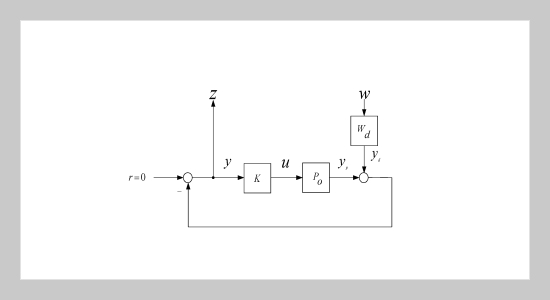REFERENCES
- [1] Doyle, J. C., Glover, K., Khargonekar P. and Francis, B. A., “State Space Solutions to Standard H2 and H� Control Problems,” IEEE Trans. on Automat. Contr., Vol. 34, pp. 831�847 (1989).
- [2] Zhou, K. and Doyle, J. C., Essentials of Robust Control, Prentice Hall, Inc. Upper Saddle River, New Jersey, U.S.A. (1998).
- [3] Gahinet, P. and Ignat, A., “Low-Order H� Synthesis via LMIs,” Proc. Amer. Contr. Conf., Baltimore, Maryland, pp. 1499�1500 (1994).
- [4] Iwasaki, T. and Skelton, R. E., “All Controllers for the General H� Control Problem: LMI Existence Conditions and State Space Formulas,” Automatica, Vol. 30, pp. 1307�1317 (1994).
- [5] Tanaka, H. and Sugie, T., “New Characterization of Fixed-Order Controllers Based on LMI,” Int. J. Contr., Vol. 72, pp. 58�74 (1999).
- [6] Du, H. and Shi, X., “Low-Order H� Controller Design Using LMI and Genetic Algorithm,” Proc. Amer. Contr. Conf., Anchorage, AK, pp. 511�512 (2002).
- [7] Grigoriadis, K. M. and Skelton, R. E., “Low-Order Control Design for LMI Problem Using Alternating Projection Method,” Automatica, Vol. 32, pp. 1117� 1125 (1996).
- [8] Mattei, M., “Sufficient Conditions for the Synthesis of H� Fixed-Order Controllers,” Int. J. Robust and Nonl. Contr.l, pp. 1237�1248 (2000).
- [9] Asai, T. and Hara, S., “A Unified Approach to LMIBased Reduced Order Self-Scheduling Control Synthesis,” Sys. and Contr. Lett., Vol. 36, pp. 75�86 (1999).
- [10] Wang, S. and Chow, J. H., “Low-Order Controller Design for SISO Systems Using Coprime Factors and LMI,” IEEE Trans. on Automat. Contr., Vol. 45, pp. 1166�1169 (2000).
- [11] Xin, X., “A Unified LMI Approach to Reduced-Order Controllers: A Matrix Pencil Perspective,” Proc. IEEE Conf. Decis. and Contr., Maui, Hawaii, pp. 5137�5142 (2003).
- [12] Henrion, D., “LMI Optimization for Fixed-Order H� Controller Design,” Proc. IEEE Conf. Decis. and Contr., Maui, Hawaii, pp. 4646�4651 (2003).
- [13] Henrion, D., Sebek, M. and Kucera, V., “Positive Polynomials and Robust Stabilization with Fixed-Order Controllers,” IEEE Trans. on Automat. Contr., Vol. 48, pp. 1178�1186 (2003).
- [14] Trofino, A., “Robust, Stable and Reduced Order Dynamic Output Feedback Controllers with Guaranteed H2 Performance,” Proc. IEEE Conf. Decis. and Contr., Maui, Hawaii, pp. 3470�3475 (2002).
- [15] Collins, E. G. Jr., Sivaprasad, A. and Selekwa, M. F., “Insights on Reduced Order H2 Optimal Controller Design Methods,” Proc. Amer. Contr. Conf., Denver, Colorado, pp. 5357�5362 (2003).
- [16] Chou, Y. S., Hsieh, K. C. and Chuang, C. M., “On the Design of Reduced-Order H2 Controllers with Coefficient Constraint,” IEEE International Midwest Symposium on Circuits and Systems, Hiroshima, Japan, pp. III-129�III-132 (2004).
- [17] Nise, N. S., Control Systems Engineering, Wiley International Edition, fourth edition (2004).
- [18] Souza, C. E. De and Shaked, U., “An LMI Method for Output-Feedback H� Control Design for System with Real Parameter Uncertainty,” Proc. IEEE Conf. Decision and Control, Tampa, Florida USA, pp. 1777� 1779 (1998).
- [19] Scherer, C. A., Gahinet, P. and Chilali, M., “Multiobjective Output-Feedback Control via LMI Optimization,” IEEE Trans. on Automat. Contr., Vol. 42, pp. 896�911 (1997).
- [20] Crusius, C. A. R. and Trofino, A., “Sufficient LMI Conditions for Output Feedback Control Problems,” IEEE Trans. on Automat. Contr., Vol. 44, pp. 1053� 1057 (1999).
- [21] Gahinet, P., Nemirovski, A., Laub, A. J. and Chilali, M., Manual of LMI Control Toolbox, the Math Works, Inc (1995).
- [22] Hsieh, K. C., “On the Design of Fixed-Order Output Feedback Controllers,” MS thesis, Department of Electrical Engineering, Tamkang University, Taipei, Taiwan, R.O.C. (2004).
- [23] Henrion, D. and Sebek, M., Fixed-order robust controller design with the Polynomial, Toolbox 3.0, Feb 21 (2003).
















